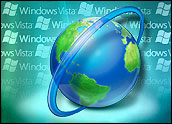
One year after Microsoft’s Vista operating system came to market, the company announced a change to its end-user licensing agreement, now allowing users to run the Vista Home Basic and Home Premium editions in a virtual environment.
The move is good news for consumers, who can run the OS on any machine, but it’s even better news for IT administrators, many of whom have been reluctant to switch to the Vista OS because there was no simple — and cheap — way to test hardware, software and network connections without sacrificing a real machine.
For administrators who work in either a Linux or Mac environment, there was no way to access the large Microsoft libraries without switching systems.
“This move is a good thing for current Microsoft customers, since it gives them more deployment and testing flexibility since they now have easy access to all versions of Vista,” Ben Rudolph, director of Parallels, a Renton, Wash.-based company specializing in virtualization software, told TechNewsWorld. “It makes it even easier for Mac and Linux users to integrate with a Windows-centric office.”
Easing IT’s Woes
Running the Vista OS in virtual environments also allows network administrators to monitor and manage large swaths of individual machines in one place, said John Whaley, founder and principal engineer for Moka5, a Redwood City, Calif.-based desktop virtualization startup. That centralized system enables the IT staff to fix and update entire networks from the virtual environment.
“By running the desktop in a virtualized machine, the IT staff can update or back up one virtual machine (independent of the user’s physical hardware) and simultaneously push the update or back up to all enterprise end users, thereby spending less time on IT issues,” Whaley said.
The end result, Whaley said, is that the IT staff can more quickly — and efficiently — deal with both individual and network problems without sacrificing quality of work.
“Virtualizing the desktop gives the IT department an easy, centralized technique for dealing with all of these problems,” Whaley said.
Dynamic Virtualization
The move is part of Microsoft’s larger “Dynamic IT” strategy. The goal: to find a simple bridge between the security needs of companies and the flexibility demands of employees, according to Bob Mugulia, senior vice president of Microsoft’s server and tools business.
“The complexity of IT has never been higher,” said Mugulia. “Business success increasingly demands on providing mobile employees with easy access to corporate computing services. People who use instant messaging, social networking sites and other relatively new communications technologies at home expect to use similar tools at work.”
At its base, Microsoft’s Dynamic IT strategy — and the decision to allow Vista to run inside virtual machines — enables companies to implement server virtualization, which gives network administrators the ability to run multiple servers off one machine, and desktop virtualization, which enables a telecommuting employee to run Vista on their home computer even if it is a Mac, Mugulia said.
Moving Forward
After a year of relative inactivity on this front, the company is now pushing the virtualization service. Microsoft announced the acquisition of Calista Technologies, a San Jose, Calif.-based company specializing in end-user interfaces for virtual desktops, and expanded its ongoing relationship with Citrix Systems, a Fort Lauderdale, Fla.-based company specializing in server virtualization.
Starting Wednesday, Microsoft will host two-day, private conference on virtualization for 300 of its customers.












































Hopefully this will be a good thing for Linux. Maybe, just maybe, it will make virtualization better off. Or maybe I’m just an optimist.